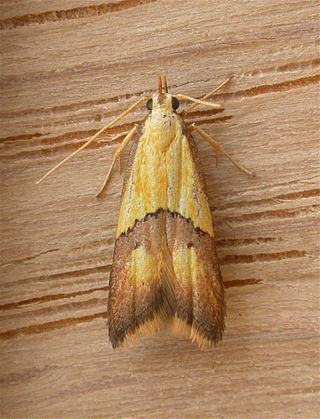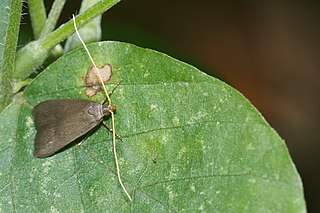Related Research Articles

The Lecithoceridae, or long-horned moths, are a family of small moths described by Simon Le Marchand in 1947. Although lecithocerids are found throughout the world, the great majority are found in the Indomalayan realm and the southern part of the Palaearctic realm.
Issikiopteryx is a genus of moths in the family Lecithoceridae.

The Lecithocerinae are a subfamily of small moths in the family Lecithoceridae. They are found worldwide, but most species occur in South Asia. The subfamily is characterized by the male genitalia with a bridge-like structure connecting the tegumen and the valva, and the uncus almost always is vestigial with two lobes at the dorsal base, only exceptionally united into a broad plate, but never as a thorn or spine.

Eois is a genus of tropical moths in the family Geometridae. It was first described by Jacob Hübner in 1818. Caterpillars of Eois species are most commonly green with darker markings, but species with fully dark caterpillars also exist. They are specialized feeders associated with Piperaceae species, with sparse additional records on Chloranthaceae species. Adults are typically small, with diverse wing shape, color and patterning across the genus.

Carodista is a genus of moths in the family Lecithoceridae. The genus was erected by Edward Meyrick in 1925.

Halolaguna is a genus of moth in the family Lecithoceridae.

Homaloxestis is a genus of moths in the family Lecithoceridae. The genus was erected by Edward Meyrick in 1910.

Lecithocera is a genus of moths in the lecithocerid subfamily Lecithocerinae. The genus was erected by Gottlieb August Wilhelm Herrich-Schäffer in 1853.
Longipenis is a genus of moths in the family Lecithoceridae.

Nosphistica is a genus of moth in the family Lecithoceridae.
Philharmonia is a genus of moth in the family Lecithoceridae.
Torodora is a genus of moths in the family Lecithoceridae. The genus was erected by Edward Meyrick in 1894.

Autosticha is a genus of gelechioid moths. It belongs to the subfamily Autostichinae, which is either placed in the concealer moth family (Oecophoridae), or in an expanded Autostichidae. It is the type genus of its subfamily. Originally, this genus was named Automola, but this name properly refers to a fly genus in family Richardiidae.
Neopectinimura is a genus of moths in the family Lecithoceridae.
Longipenis deltidius is a moth in the family Lecithoceridae. It is found in Fujian, China.
Longipenis paradeltidius is a moth in the family Lecithoceridae. It is found in Guangxi, China.
Longipenis dentivalvus is a moth in the family Lecithoceridae. It is found in Guangdong, China.

Synersaga is a genus of moths in the family Lecithoceridae.
Woonpaikia angoonae is a moth in the family Lecithoceridae. It was described by Kyu-Tek Park in 2010. It is found in Thailand.
Woonpaikia villosa is a moth in the family Lecithoceridae. It was described by Kyu-Tek Park in 2010. It is found in Thailand.
References
- ↑ Savela, Markku (August 23, 2017). "Woonpaikia Park, 2010". Lepidoptera and Some Other Life Forms. Retrieved November 5, 2019.
- ↑ Yu, Shuai; Wang, Shuxia (February 19, 2024). "First report of the genus Woonpaikia Park, 2010 (Lepidoptera, Lecithoceridae) from China, with the description of two new species". ZooKeys (1192): 1–7. doi: 10.3897/zookeys.1192.115033 . PMID 38419741.